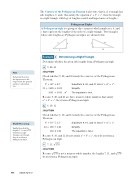Page 573 - Algebra 1
P. 573
The Converse of the Pythagorean Theorem is also true; that is, if a triangle has side lengths a, b, and c that satisfy the equation a2 + b2 = c2, then the triangle is a right triangle with legs of lengths a and b and hypotenuse of length c.
Pythagorean Triples
A Pythagorean triple is a group of three nonzero whole numbers a, b, and c that represent the lengths of the sides of a right triangle. Two triangles whose side lengths are Pythagorean triples are shown below.
5
4
3
5
13 12
Determining a Right Triangle
Determine whether the given side lengths form a Pythagorean triple.
a. 9, 40, 41
SOLUTION
Check whether 9, 40, and 41 satisfy the converse of the Pythagorean Theorem.
Example
2
Hint
Remember that since the hypotenuse is the longest side, the greatest number is subsituted
for c.
92 + 402 412 81 + 1600 1681
Substitute 9, 40, and 41 into a2 + b2 = c2. Simplify.
The equation is true.
1681 = 1681 ✓
Because 9, 40, and 41 are three nonzero whole numbers that satisfy
a2 + b2 = c2, they form a Pythagorean triple.
b. 8, 10, 12
SOLUTION
Check whether 8, 10, and 12 satisfy the converse of the Pythagorean Theorem.
82 + 102 122 64 + 100 144 164 ≠ 144
Substitute 8, 10, and 12 into a2 + b2 = c2. Simplify.
The equation is false.
Math Reasoning
Verify Show that the lengths 7, 11, and √ 17 0 determine a right triangle, even though they do not form a Pythagorean triple.
Because 8, 10, and 12 do not satisfy a2 + b2 = c2, they do not form a Pythagorean triple.
c. 7,11,√ 17 0 SOLUTION
Because √1 7 0 is not a nonzero whole number, the lengths 7, 11, and √1 7 0 do not form a Pythagorean triple.
558 Saxon Algebra 1


